-
IP addresses are NOT logged in this forum so there's no point asking. Please note that this forum is full of homophobes, racists, lunatics, schizophrenics & absolute nut jobs with a smattering of geniuses, Chinese chauvinists, Moderate Muslims and last but not least a couple of "know-it-alls" constantly sprouting their dubious wisdom. If you believe that content generated by unsavory characters might cause you offense PLEASE LEAVE NOW! Sammyboy Admin and Staff are not responsible for your hurt feelings should you choose to read any of the content here. The OTHER forum is HERE so please stop asking.
You are using an out of date browser. It may not display this or other websites correctly.
You should upgrade or use an alternative browser.
You should upgrade or use an alternative browser.
China WARN Netherlands with Sanction on ASML Chipmaking Tools
- Thread starter LaoTze
- Start date
Actually ASML wants to sell to China ..it is the Americans that stop them.
ASML lose business and waits for the emergence of Chinese competitors.
ASML lose business and waits for the emergence of Chinese competitors.
It's the US that is destroying free trade and capitalism.
But it's too late to impose on China. It has grown economically and to many European companies, china market is as big if not bigger than the US.
But it's too late to impose on China. It has grown economically and to many European companies, china market is as big if not bigger than the US.
The Dutch are very unhappy with the US sanctions on China, because it's billions of dollars lost for them.Actually ASML wants to sell to China ..it is the Americans that stop them.
ASML lose business and waits for the emergence of Chinese competitors.
For the time being it's lan lan going along with US dictates. Let's see how it pans out when China turns the screws.
Hahah. The Dutch should be happy that china didn't get their hands on the machine.
They will actually take out the machine and reassemble the machine.
They will also threathen the Dutch that if they don't pass the information and technique and data to make the machine, they will stop the investing.
Thank God China CCP is doing things the hardway
They will actually take out the machine and reassemble the machine.
They will also threathen the Dutch that if they don't pass the information and technique and data to make the machine, they will stop the investing.
Thank God China CCP is doing things the hardway
These sanctions will force China to come up with its own technology, either by reverse engineering or by pouring more money into R & D. Eventually China will get there.Hahah. The Dutch should be happy that china didn't get their hands on the machine.
They will actually take out the machine and reassemble the machine.
They will also threathen the Dutch that if they don't pass the information and technique and data to make the machine, they will stop the investing.
Thank God China CCP is doing things the hardway
So what will all these sanction achieve? Just buy more time for the US and its allies, maybe 3-5 years lead time. But you lose a lot of business in the meantime. And when China surpasses the West in chip technology you can be sure they'll play hardball too.
That's why I say the sanctions don't make sense for all parties in the long term from the economic angle. Economic decisions based on political considerations almost always don't work out well.
Last edited:
These sanctions will force China to come up with its own technology, either by reverse engineering or by pouring more money into R & D. Eventually China will get there.
So what will all these sanction achieve? Just buy more time for the US and its allies, maybe 3-5 years lead time. But you lose a lot of business in the meantime. And when China surpasses the West in chip technology you can be sure they'll play hardball too.
That's why I say the sanctions don't make sense for all parties in the long term from the economic angle.
Just bear in mind much , if not all, of the research done on semiconductors were done by Chinese minds working in USA and Europe then.
Most of them, at least 90% returned to China.
Their inventive genius will fllourish even more , and what they done for USA and Europe will pale in comparison to what they be doing now and into the future
MURICA AND NETHERLAND AND JAPAN FUCKED AND TIEWED THEMSELVES AMONG THEMSELVES
That's why America has screwed themselves up. If this continues, economic decoupling aside, the West will lag further behind China (and BRICs0 in many areas. China has already filed 6x more patents in AI than the US from 2014 to 2023, for example.Just bear in mind much , if not all, of the research done on semiconductors were done by Chinese minds working in USA and Europe then.
Most of them, at least 90% returned to China.
Their inventive genius will fllourish even more , and what they done for USA and Europe will pale in comparison to what they be doing now and into the future
MURICA AND NETHERLAND AND JAPAN FUCKED AND TIEWED THEMSELVES AMONG THEMSELVES
All these pigheaded decisions from the Trump admin onwards are just lose-lose-lose propositions for the West and whole world.
Last edited:
Just bear in mind much , if not all, of the research done on semiconductors were done by Chinese minds working in USA and Europe then.
Most of them, at least 90% returned to China.
Their inventive genius will fllourish even more , and what they done for USA and Europe will pale in comparison to what they be doing now and into the future
MURICA AND NETHERLAND AND JAPAN FUCKED AND TIEWED THEMSELVES AMONG THEMSELVES
View attachment 206034
https://www.scmp.com/news/china/sci...helped-build-us-semiconductor-empire-timeline
How Chinese engineers helped build the US semiconductor empire: a timeline, 80 or 90 per cent of them have already returned to China
While the US dominates the field of advanced electronics globally, there have been many Chinese academics who have helped this achievement
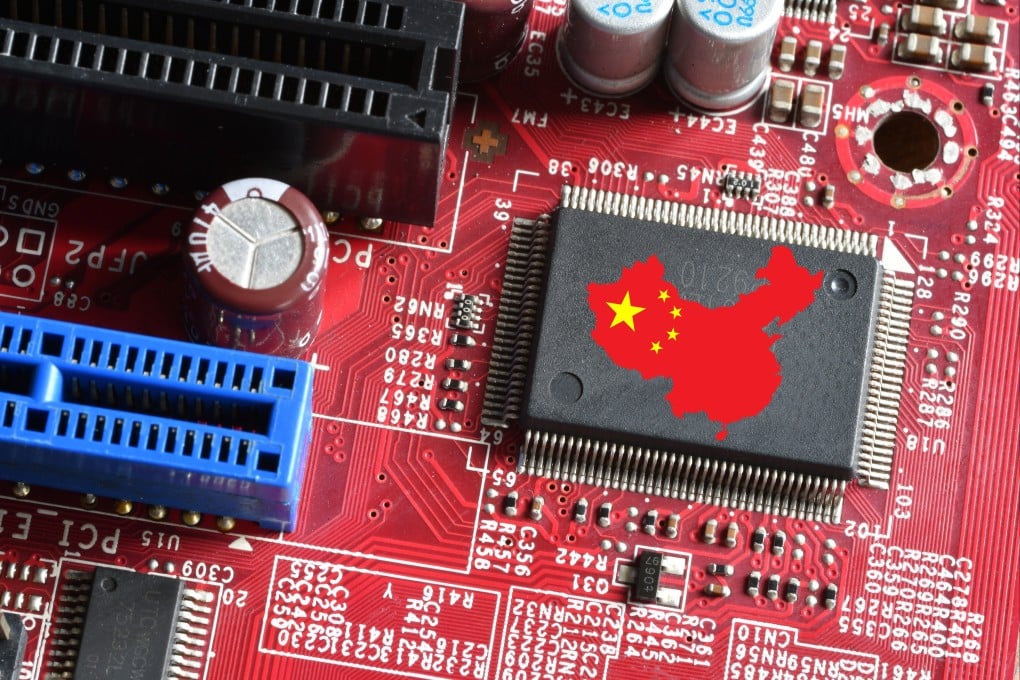
Victoria Bela
Published: 6:00pm, 3 Sep 2024
From building the first electronic computer to maintaining a stronghold of semiconductor design, the United States has long shined as a beacon for advanced electronics development.
But behind America’s rise stand many Chinese scientists and engineers whose monumental contributions have largely remained in the shadows.
Gerald Yin Zhiyao, co-founder and chief executive officer of Advanced Micro-Fabrication Equipment Inc China (AMEC) – China’s leading semiconductor equipment maker – recently disclosed a shocking figure about these contributions.
During a show in July run by the Shanghai Stock Exchange and China National Radio Network, he talked about the fact that over the last 40 years, many of the most advanced semiconductor etching machines have come out of Silicon Valley, the centre of US tech innovation.
“When you actually look at the equipment, who’s doing it, it’s actually 70 to 80 per cent Chinese students,” Yin said. He spent decades working in the US and co-founded the Chinese Engineers Association of Silicon Valley in the late 1980s.
But now, “80 or 90 per cent of them have already returned” to China, he added.
XXXXXXXXXXXXXXXXXXXXXXXXXXXXXXXXXXXXXXXXXXXXXXXXXXXXXXXXXXXXXXXXXXXXX
As China and the US fight for dominance over key science and technology fields, the reality of a long-standing talent transfer between the nations underlies the field of advanced electronics.
Here the Post examines Chinese-born innovators who have contributed to the development of advanced computing in the US – and who have had a global impact.
Jeffrey Chuan Chu (Zhu Chuanju)
1946 – World’s First Electronic ComputerIn 1946, the new age of computing began with the world’s first general-purpose electronic computer, known as the Electronic Numerical Integrator and Computer (ENIAC), which was developed by a team at the University of Pennsylvania.
A core member of that team was Jeffrey Chuan Chu, who is credited with designing parts of the computer’s logical structure.
Chu was born in Tianjin in 1919 and moved to the US to attend university as a result of World War II. He won the first ever Institute of Electrical and Electronics Engineers (IEEE) Computer Pioneer Award in 1981 for this early work on logic design.
Following his work on the ENIAC, in the 1940s and early 1950s Chu worked on a number of other early computer projects including Argonne National Laboratories first digital computer, AVIDAC, and the Universal Automatic Computer (UNIVAC), the first electronic digital computer designed for business.
In his 2011 obituary, his family called Chu a “computer pioneer and passionate crusader for US-China cultural exchange”.
In 1980, Chu met Deng Xiaoping and shared ideas for how China could go about modernising its technology and business, as he also outlined in a letter a year prior, many of which China ended up implementing.
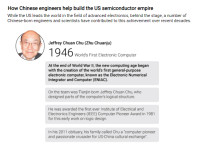
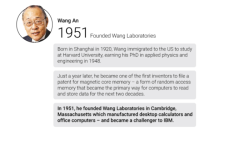
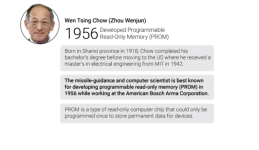
Wang An
1951 – Founded Wang LaboratoriesBorn in Shanghai in 1920, Wang immigrated to the US to study at Harvard University, earning his PhD in applied physics and engineering in 1948.
Just a year later, he became one of the first inventors to file a patent for magnetic core memory – a form of random access memory that became the primary way for computers to read and store data for the next two decades.
In 1951, he founded Wang Laboratories in Cambridge, Massachusetts which manufactured desktop calculators and office computers – and became a challenger to IBM.
Although the company eventually had a fall in the 1980s, it served as a major hi-tech company in the US with a lasting legacy.
Chu even briefly served as the senior vice-president of North American marketing for Wang Laboratories in the 1970s.
Wen Tsing Chow (Zhou Wenjun)
1956 – Developed Programmable Read-Only Memory (PROM)Born in Shanxi province in 1918, Chow completed his bachelor’s degree before moving to the US where he received a master’s in electrical engineering from the Massachusetts Institute of Technology in 1942.
The missile-guidance and computer scientist is best known for developing programmable read-only memory (PROM) in 1956 while working at the American Bosch Arma Corporation.
PROM is a type of read-only computer chip that could only be programmed once to store permanent data for devices.
In the 1960s, he made significant advancements in computer-guided navigation, verifying software implementation and guidance equations for Nasa’s Project Gemini, according to a report commissioned by the Committee of 100, an organisation of Chinese-Americans.
His pioneering work allowed for the miniaturisation of computer components for use in guidance, paving the way for the implementation of digital computers in spacecraft and missiles, according to the report.
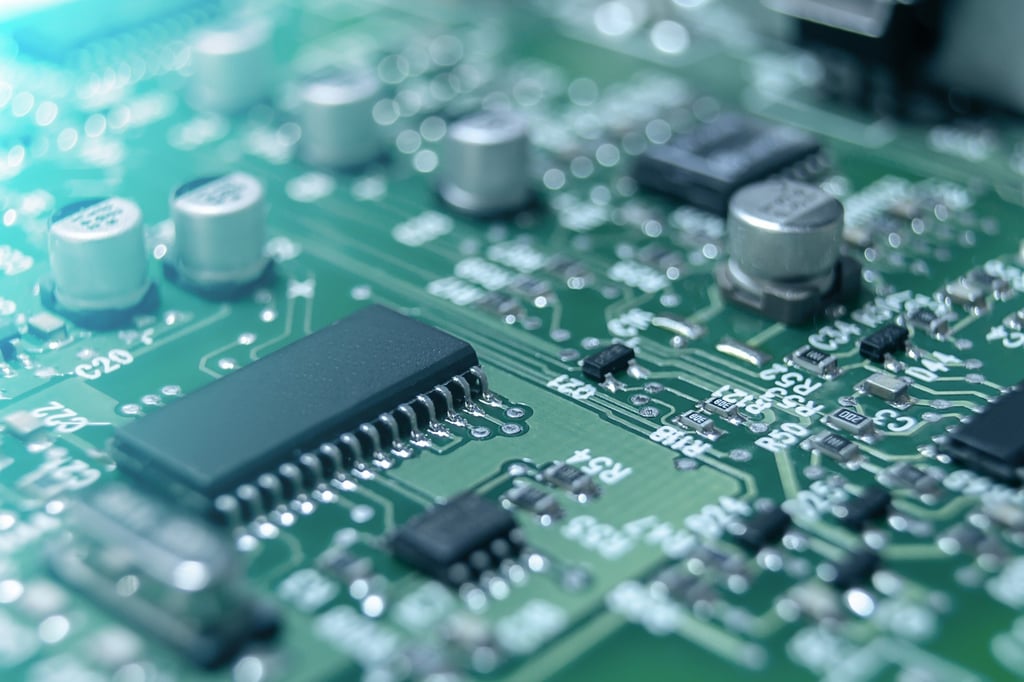
CMOS, invented by Chih-Tang Sah, is now used in the vast majority of integrated circuits in devices around the world. Photo: Shutterstock
Chih-Tang Sah (Sa Zhitang)
1963 – Invented Complementary Metal-Oxide-Semiconductor (CMOS)Born in Beijing in 1932, Chih-Tang Sah is a key figure in the advancement of integrated circuit chips and computing capabilities.
After receiving degrees in electrical engineering from the University of Illinois and Stanford University, Sah began working at the Fairchild Semiconductor Corporation in California.
In 1963, Sah and fellow engineer Frank Wanlass invented the complementary metal-oxide-semiconductor (CMOS), which they presented in a paper at an IEEE conference.
CMOS is now used to manufacture the vast majority of integrated circuits including memory chips and computer processors, as it creates reliable low-power electronic circuits and helps store system settings and configurations.
The development of CMOS pushed through the advancement of integrated circuits for use in phones, computers and televisions, according to the Committee of 100 report.
Jensen Huang
1993 – Co-founded NVIDIAJensen Huang co-founded the semiconductor manufacturing company NVIDIA in 1993, and has served as its chief executive ever since.
NVIDIA popularised the term graphics processing units (GPUs) in 1999 with the release of the GeForce 256 – which the company claimed was the world’s first GPU – reshaping the computer industry.
Born in Tainan, Taiwan in 1963, Huang received a degree in electrical engineering at Oregon State University in 1984 before working at Silicon Valley while also studying for his master’s from Stanford University.
Generative AI is the single most significant platform transition in computing history and will transform every industry, including gaming
Jensen Huang
NVIDIA has shifted its focus over the years to heavily emphasise the development of chips for AI computing.
“Generative AI is the single most significant platform transition in computing history and will transform every industry, including gaming,” Huang said in a news release in January.
According to its website, the company now produces some of the most advanced AI chips and software for use in many industries including healthcare and autonomous vehicles.
Chenming Calvin Hu (Hu Zhengming)
1999 – Invented the fin field-effect transistor (FinFET)Beijing-born microelectronics expert Chenming Hu is known as the “father of the 3D transistor” for his invention of the fin field-effect transistor (FinFET) in 1999.
FinFET – a type of transistor which controls the flow of electrical currents in chips – became the basis of modern nanoelectronic semiconductor device fabrication.
A record number of transistors could be fitted onto a chip using this invention, extending Moore’s Law – the observation that the number of transistors on a chip should double every two years – which many thought would soon die.
US proposes new round of tariffs on China in latest trade war escalation
This invention of a finlike transistor that took up less surface area than 2D transistors allowed for the development of higher processing capabilities on increasingly smaller devices.
After completing his bachelor’s degree in Taipei, the electrical engineer completed his master’s and PhD at the University of California, Berkeley. He served as the chief technology officer of the Taiwan Semiconductor Manufacturing Company from 2001 to 2004.
In 2014, Hu was awarded the US National Medal of Technology and Innovation by Barack Obama for his pioneering work on transistors.
Li Fei-Fei
2006 – Developed ImageNetBorn in Beijing in 1976, the former vice-president of Google and current co-director of Stanford University’s Institute for Human-Centred Artificial Intelligence (HAI) is one of the biggest players in the ongoing AI revolution.
In 2006, Li Fei-Fei began the ImageNet project which was published in 2009, a large-scale data set of digital images that laid the foundation for AI computer vision training, instrumental in advancing deep learning research.
Li received her PhD in electrical engineering from the California Institute of Technology in 2005, directed the Stanford AI Lab from 2013 to 2018, and served as the chief AI/ML scientist at Google Cloud from 2017 to 2018.
Her work now focuses on the development of cognitively inspired AI, especially for use in healthcare.
Li is this year’s recipient of the IEEE computer pioneer award for her work in advancing computer vision, particularly for the development of ImageNet.
She is the second Chinese-born recipient of this award – the same one Jeffrey Chuan Chu was the first ever recipient over just over 40 years ago.
XXXXXXXXXXXXXXXXXXXXXXXXXXXXXXXXXXXXXXXXXXXX
As China and the US fight for dominance over key science and technology fields, the reality of a long-standing talent transfer between the nations underlies the field of advanced electronics.
Here the Post examines Chinese-born innovators who have contributed to the development of advanced computing in the US – and who have had a global impact.
Jeffrey Chuan Chu (Zhu Chuanju)
1946 – World’s First Electronic ComputerIn 1946, the new age of computing began with the world’s first general-purpose electronic computer, known as the Electronic Numerical Integrator and Computer (ENIAC), which was developed by a team at the University of Pennsylvania.
A core member of that team was Jeffrey Chuan Chu, who is credited with designing parts of the computer’s logical structure.
Chu was born in Tianjin in 1919 and moved to the US to attend university as a result of World War II. He won the first ever Institute of Electrical and Electronics Engineers (IEEE) Computer Pioneer Award in 1981 for this early work on logic design.
Following his work on the ENIAC, in the 1940s and early 1950s Chu worked on a number of other early computer projects including Argonne National Laboratories first digital computer, AVIDAC, and the Universal Automatic Computer (UNIVAC), the first electronic digital computer designed for business.
In his 2011 obituary, his family called Chu a “computer pioneer and passionate crusader for US-China cultural exchange”.
In 1980, Chu met Deng Xiaoping and shared ideas for how China could go about modernising its technology and business, as he also outlined in a letter a year prior, many of which China ended up implementing.



Wang An
1951 – Founded Wang LaboratoriesBorn in Shanghai in 1920, Wang immigrated to the US to study at Harvard University, earning his PhD in applied physics and engineering in 1948.
Just a year later, he became one of the first inventors to file a patent for magnetic core memory – a form of random access memory that became the primary way for computers to read and store data for the next two decades.
In 1951, he founded Wang Laboratories in Cambridge, Massachusetts which manufactured desktop calculators and office computers – and became a challenger to IBM.
Although the company eventually had a fall in the 1980s, it served as a major hi-tech company in the US with a lasting legacy.
Chu even briefly served as the senior vice-president of North American marketing for Wang Laboratories in the 1970s.
Wen Tsing Chow (Zhou Wenjun)
1956 – Developed Programmable Read-Only Memory (PROM)Born in Shanxi province in 1918, Chow completed his bachelor’s degree before moving to the US where he received a master’s in electrical engineering from the Massachusetts Institute of Technology in 1942.
The missile-guidance and computer scientist is best known for developing programmable read-only memory (PROM) in 1956 while working at the American Bosch Arma Corporation.
PROM is a type of read-only computer chip that could only be programmed once to store permanent data for devices.
In the 1960s, he made significant advancements in computer-guided navigation, verifying software implementation and guidance equations for Nasa’s Project Gemini, according to a report commissioned by the Committee of 100, an organisation of Chinese-Americans.
His pioneering work allowed for the miniaturisation of computer components for use in guidance, paving the way for the implementation of digital computers in spacecraft and missiles, according to the report.

CMOS, invented by Chih-Tang Sah, is now used in the vast majority of integrated circuits in devices around the world. Photo: Shutterstock
Chih-Tang Sah (Sa Zhitang)
1963 – Invented Complementary Metal-Oxide-Semiconductor (CMOS)Born in Beijing in 1932, Chih-Tang Sah is a key figure in the advancement of integrated circuit chips and computing capabilities.
After receiving degrees in electrical engineering from the University of Illinois and Stanford University, Sah began working at the Fairchild Semiconductor Corporation in California.
In 1963, Sah and fellow engineer Frank Wanlass invented the complementary metal-oxide-semiconductor (CMOS), which they presented in a paper at an IEEE conference.
CMOS is now used to manufacture the vast majority of integrated circuits including memory chips and computer processors, as it creates reliable low-power electronic circuits and helps store system settings and configurations.
The development of CMOS pushed through the advancement of integrated circuits for use in phones, computers and televisions, according to the Committee of 100 report.
Jensen Huang
1993 – Co-founded NVIDIAJensen Huang co-founded the semiconductor manufacturing company NVIDIA in 1993, and has served as its chief executive ever since.
NVIDIA popularised the term graphics processing units (GPUs) in 1999 with the release of the GeForce 256 – which the company claimed was the world’s first GPU – reshaping the computer industry.
Born in Tainan, Taiwan in 1963, Huang received a degree in electrical engineering at Oregon State University in 1984 before working at Silicon Valley while also studying for his master’s from Stanford University.
Generative AI is the single most significant platform transition in computing history and will transform every industry, including gaming
Jensen Huang
NVIDIA has shifted its focus over the years to heavily emphasise the development of chips for AI computing.
“Generative AI is the single most significant platform transition in computing history and will transform every industry, including gaming,” Huang said in a news release in January.
According to its website, the company now produces some of the most advanced AI chips and software for use in many industries including healthcare and autonomous vehicles.
Chenming Calvin Hu (Hu Zhengming)
1999 – Invented the fin field-effect transistor (FinFET)Beijing-born microelectronics expert Chenming Hu is known as the “father of the 3D transistor” for his invention of the fin field-effect transistor (FinFET) in 1999.
FinFET – a type of transistor which controls the flow of electrical currents in chips – became the basis of modern nanoelectronic semiconductor device fabrication.
A record number of transistors could be fitted onto a chip using this invention, extending Moore’s Law – the observation that the number of transistors on a chip should double every two years – which many thought would soon die.
US proposes new round of tariffs on China in latest trade war escalation
This invention of a finlike transistor that took up less surface area than 2D transistors allowed for the development of higher processing capabilities on increasingly smaller devices.
After completing his bachelor’s degree in Taipei, the electrical engineer completed his master’s and PhD at the University of California, Berkeley. He served as the chief technology officer of the Taiwan Semiconductor Manufacturing Company from 2001 to 2004.
In 2014, Hu was awarded the US National Medal of Technology and Innovation by Barack Obama for his pioneering work on transistors.
Li Fei-Fei
2006 – Developed ImageNetBorn in Beijing in 1976, the former vice-president of Google and current co-director of Stanford University’s Institute for Human-Centred Artificial Intelligence (HAI) is one of the biggest players in the ongoing AI revolution.
In 2006, Li Fei-Fei began the ImageNet project which was published in 2009, a large-scale data set of digital images that laid the foundation for AI computer vision training, instrumental in advancing deep learning research.
Li received her PhD in electrical engineering from the California Institute of Technology in 2005, directed the Stanford AI Lab from 2013 to 2018, and served as the chief AI/ML scientist at Google Cloud from 2017 to 2018.
Her work now focuses on the development of cognitively inspired AI, especially for use in healthcare.
Li is this year’s recipient of the IEEE computer pioneer award for her work in advancing computer vision, particularly for the development of ImageNet.
She is the second Chinese-born recipient of this award – the same one Jeffrey Chuan Chu was the first ever recipient over just over 40 years ago.
XXXXXXXXXXXXXXXXXXXXXXXXXXXXXXXXXXXXXXXXXXXX
Justin Kan founded twitch .
Fred Chang – founder of Newegg, billionaire.
Pehong Chen – founder of Gain Technology and Broadvision.
Perry Chen – co-founder of Kickstarter.
Ben Chiu – founder of KillerApp.com.
Tracy Chou – Project Include, former Pinterest and Quora engineer.
Daniel Ha – co-founder of Disqus.
Jerry Yang (born 1968) co-founded Yahoo.
Steve Chen (born 1978) co-founded YouTube.
Eric Yuan (born 1970) founded Zoom
,tony xu founded door dash,
Jensen Huang founded Nvidia.
Yan Huo – co-founder of Capula Investment Management, 8th largest hedge fund in Europe by assets .
Gary Wang Cofounder of ftx.
Also CEO of binance, bybit,okx,and merc we own most of the crypto exchanges
Steve Chen – founder and CEO of Galactic Computing
James Chu – founder, CEO and chairman of ViewSonic, one of the largest computer monitor brands
Alfred Chuang – co-founder BEA Systems (acquired by Oracle for $8.5 billion in 2008
Don't forget David lam the
Founder of lam research check him out.
Min Zhu – co-founder of WebEx (sold to Cisco Systems for $3.2 billion)
Lisa su (CEO of AMD)
Peng Zhao – CEO of Citadel Securities
Patrick Soon-Shiong – founder of Abraxis BioScience and NantHealth, billionaire
Lip-Bu Tan – president and CEO of Cadence Design Systems
Victor Tsao – co-founder of Linksys (sold to Cisco Systems for $500 million)
Bing Yeh – founder of Silicon Storage Technology and Greenliant Systems( micro chip technology very important)
Unlike indians CEO who took over someone else hardwork Chinese Americans are built different.
Sit down homeboy u have a lot more to learn daddy will show you. See how Chinese CEO are mostly founder someone who actually invented things. Give me a break dude .
Feng-hsiung Hsu (許峰雄) – IBM developer of Deep Blue, which beat World Chess Champion Garry Kasparov in 1997
Don't forget burn Jeng lin the god of semiconductor.
Wen Tsing Chow (周文俊) – missile guidance scientist, digital computer pioneer
Chinese founders and engineers are endless I can list a lot more but I'm too lazy right now sheesh. Don't play with me
China is still not available yet. But they do excel on their cheating.
Every country cheats, including the USA. That's competition ...win at all costs.
Similar threads
- Replies
- 13
- Views
- 813
- Replies
- 2
- Views
- 273
- Replies
- 6
- Views
- 330
